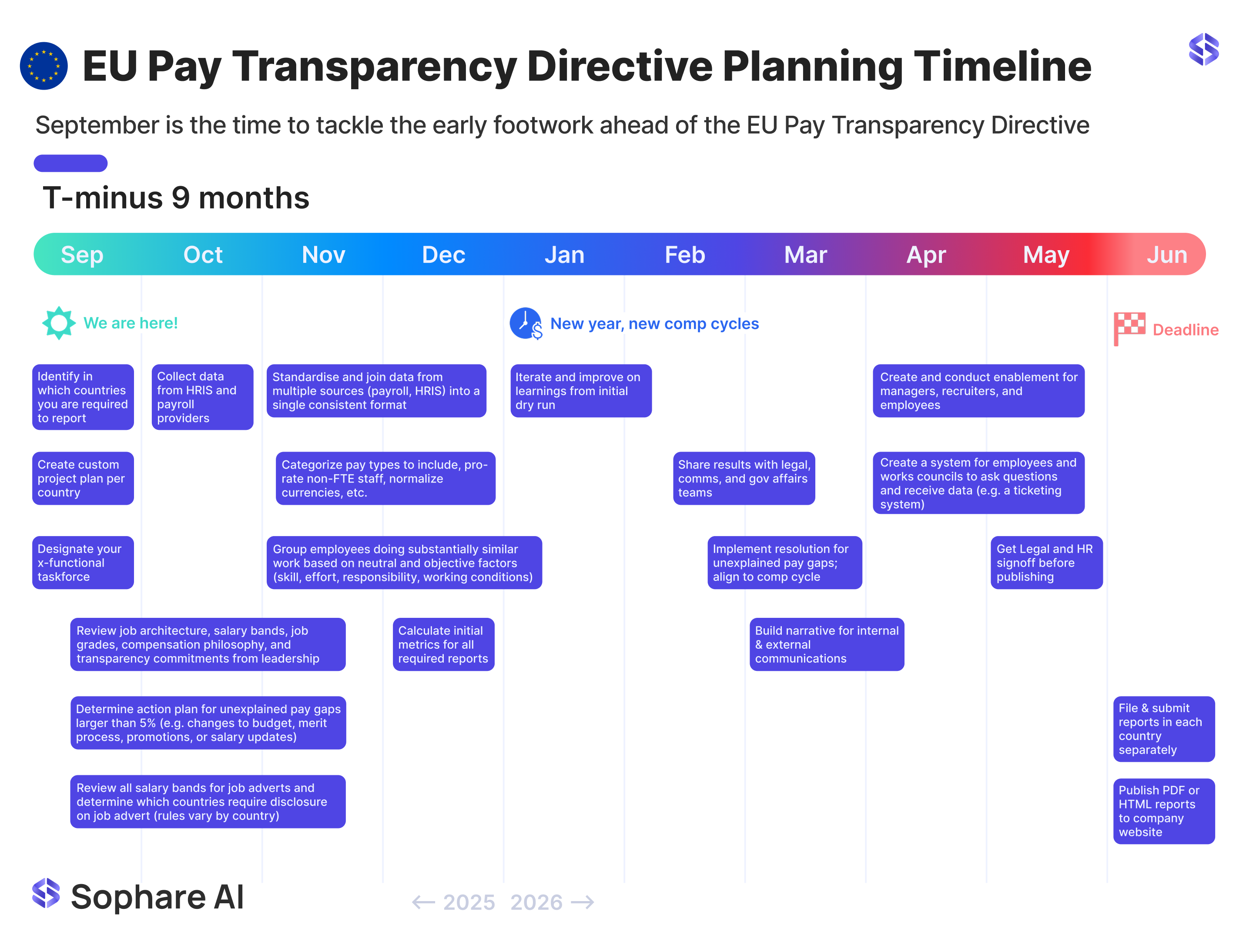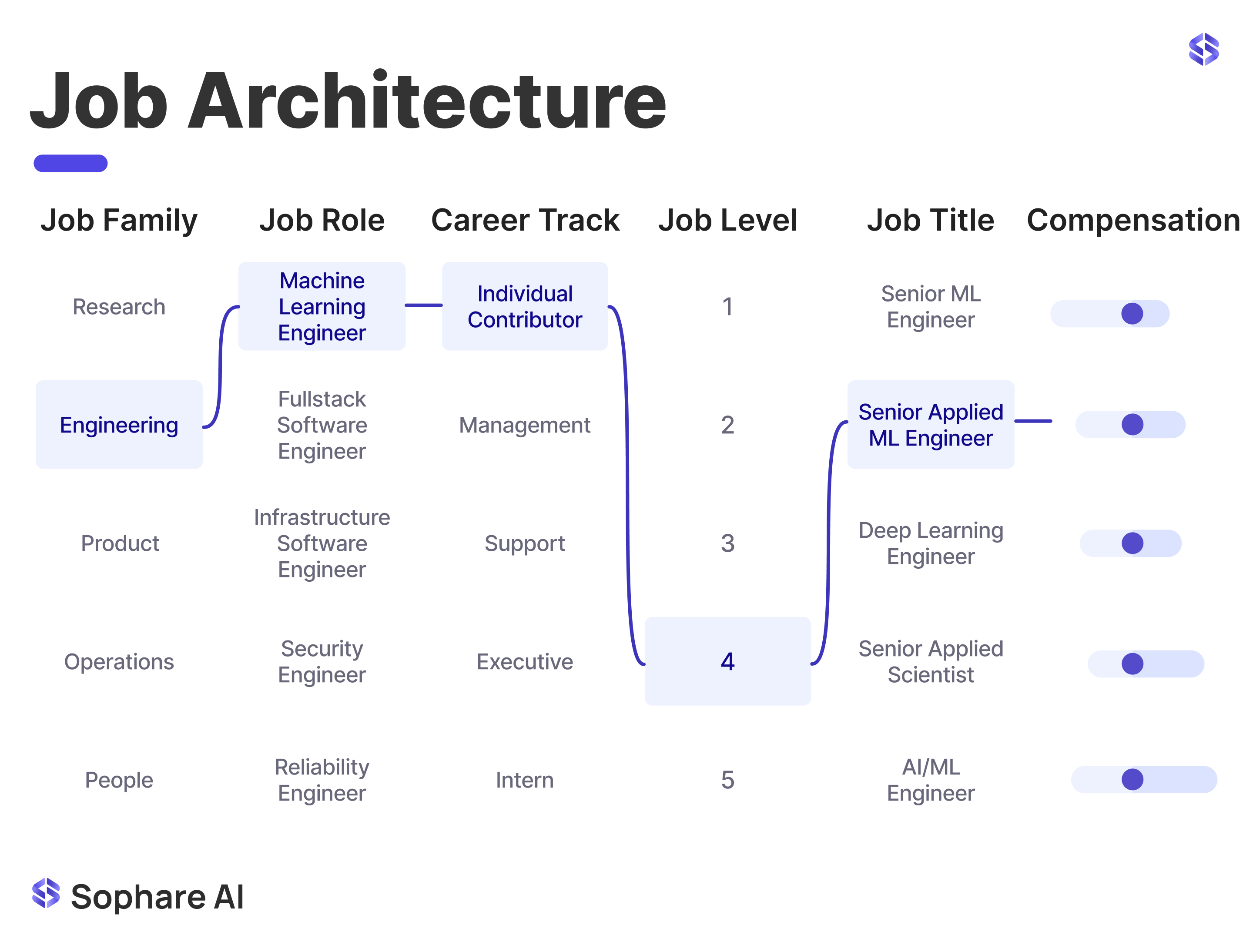9 Months to Go: The Importance of Job Architectures for Pay Equity
7 September 2025 marks the 9-month countdown to the 🇪🇺 EU Pay Transparency Directive going live.
With the EU Pay Transparency Directive coming into force in June 2026, SMB companies across Europe are facing a fundamental shift in how they approach compensation. One of the most critical (and often overlooked) foundations for compliance and equal pay reporting is a clear, consistent job architecture.
September 2025 Action Plan for EU Pay Transparency Directive Compliance
All August items:
Including establishing your taskforce, creating a project plan and roadmap of your company's pay transparency journey, and exploring
Review your job architecture: Follow our 10-step guide below if creating a job architecture from scratch. Also take time to review your company's compensation philsophy and leadership's commitment to transparency (hint, it's not black-and-white;
transparency commitment falls on a spectrum!
)
Determine an action plan: For unexplained pay gaps larger than 5%, determine a remediation plan. Remediation may require budgetary changes,changes to merit planning, promotions, or salary updates.

Why Job Architecture Is Essential for Pay Equity
Job architecture is the structured framework that defines how roles are organised, evaluated, and compensated. This structure allows you to group employees accurately, compare like-for-like roles, and take meaningful action to close unexplained pay gaps. Without it, even the most sophisticated equal pay analysis risks producing misleading results.
At its core, a job architecture includes:
- Job functions: High level divisions such as HR, Finance, Sales, Engineering
- Job role: Classification of each position into consistent titles (e.g. Frontend Engineer, Backend Engineer, ML Engineer)
- Career track: Individual Contributor vs. Manager vs. Executive
- Job grades: Levels that group roles by scope, responsibility, and complexity (e.g. L1, L2, L3, etc.)
- Job titles: These match the job roles with the job grade and career track (e.g. Senior Backend Engineer)

When done well, job architecture allows you to:
- Compare pay between equivalent roles
- Identify pay disparities more accurately
- Provide transparency and career development clarity for employees
Without a robust job architecture, “equal work” or “work of equal value” which is a key concept in the Directive becomes subjective and open to challenge.
10 steps to create Job Architecture from scratch at your firm
- Gather Role Data – Compile a complete list of positions in the company, including job descriptions, responsibilities, and reporting lines. You can start by pulling a list of all the existing employees and their job titles to identify roles as well as existing job descriptions from the recruitment team.
- Group Roles into Job Functions/Families – Organise roles into broad groups (e.g., Engineering, Marketing, Sales) to keep the structure manageable. Depending on the size of the company you may need to introduce job families too as a sub group of job functions.
- Audit Roles & Titles – Simplify existing titles and job descriptions. Remove overlap and misleading titles. For example, an employee given a Manager title but the role would never have direct reports.
- Standardise Title Conventions – Decide how to communicate seniority clearly (e.g., Analyst → Senior Analyst → Lead Analyst) and apply it consistently across the business (e.g., keep only one of these: Senior Account Executive vs. Account Executive, Sr. vs. Sr. AE).
- Create a Leveling Framework – Use a unified structure (e.g., levels for Individual Contributor, Manager, Executive) across all functions.
- Define Evaluation Criteria – Select consistent factors (such as scope, decision-making authority, and required skills) to assess each role. Remember a key requirement in the Directive is to demonstrate to employees how their career paths could be, with clear descriptions on what it will take to advance to the next level.
- Establish Job Grades – Group roles into logical levels based on the evaluation criteria. Each grade should reflect a similar level of responsibility and value to the organisation.
- Map All Roles – Assign every position to the correct title, grade, job function, career track level, ensuring consistency across departments.
- Document and Communicate – Publish the architecture internally so employees understand where they fit and how they can progress.
- Review Regularly – Revisit the framework annually or when significant organisational changes occur.
Once your job architectire is set-up, you can create salary bands at each level and gather external data for benchmarking. More on that in a future blog post.
Where Sophare AI Can Help
- Our consultants can provide feedback on your existing job architecture framework before we begin the pay equity process
- Our AI-native platform will ingest your job architecture to autogenerate compliance-ready grouping structures to meet the EU Pay Transparency Directive’s equal pay for equal value requirement
- We will use this to identify pay disparity between similar roles and recommend ways to close the gap to avoid expensive fines in advance of your reporting deadline
Take action now
In our experience, building a job architecture from scratch in-house could take up to 3 months depending on the size of your organization and review cycles. With 9 months left to go to the June 2026 deadline, the time to act on it is now! If you do not have a large enough internal HR team to do this work, you will need to hire externally or engage consultants who are all in high demand and short supply the closer you get to the deadline. The earlier you start, the more confidently you can publish accurate, defensible pay gap reports and demonstrate your commitment to pay equity.
Don’t wait until your first report is due. Begin mapping your roles today. While our technology is powerful, our customers also value our boutique approach. We work as a true partner, tailoring solutions to your unique workforce and compliance needs. Many of our customers tell us this combination of innovative AI with a hands-on, collaborative relationship is what makes Sophare the most trusted partner for pay equity and pay transparency in 2025.
